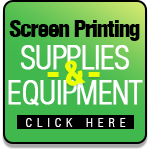Learn How To Screen Print With Catspit Productions, LLC
Types Of Film Positives
Types Of Film Positives For Making Screens
Creating film positive is one of the steps that can be confusing and frustrating for home printers and beginners alike. The most important factor in making them is often overlooked. The principle of the film positive is to block the exposure source light from curing the emulsion during exposure. Therefore, film positives will work the best when they are absolutely opaque.
It can be very difficult to print completely black inkjet or laser film positives at home without the proper films and software to control your printer. But there are several ways to make film positives that you should be aware of.
Laser Films - This type of film is less popular most likely because density is very hard to control. Toner can only be controlled so much by printer settings and may be affected by toner cartridge age. They are made of clear plastic film bases. Distortion may be a problem in larger images due to the heat of the fuser.
Laser Vellum - This type of film positive is less popular most likely because density is very hard to control. Toner can only be controlled so much by printer settings and may be affected by toner cartridge age. This is a transparent paper product. This medium also has the disadvantage of possible shrinkage or wrinkling in the fuser. This can be a problem with multi colored jobs and their registration on press.
Thermal Films - These are films produced by means of a thermal printer. They are made of clear plastic film bases. This system can be much more expensive than inkjet or laser film producing processes. But the film is very high quality and always very dense. This produces very opaque film positives. You can have this type of film positive made for you for a fee.
Image Setter Film - This has to be the absolute best way to produce film positives for screen making. They are made of clear plastic film bases. This is the system that actually replaced stat and process cameras when film positives were made using actual silver nitrate films and processed in a darkroom. But image setters are very, very expensive and most often only large print houses will have the demand for them. But you can often find such a print house in a city near you. You can have this type of film positive made for you for a fee.
Copier Transparencies - These have to be the poorest of all film positives ever used for screen printing. They are made of clear plastic film bases. They are very poor quality in resolution and density. They often need to be doubled up in order to achieve the opacity required for screen making. The benefit to this method it that they are readily available at most copy stores.
Plotter Cut Vinyl On Clear Acetate - This is a home brew process that results in very opaque film positives. They are made of clear plastic film bases with plotter cut vinyl graphics applied to the film. These films are great to make especially if you are a sign maker and have the plotter and perhaps an odd color vinyl you want to get rid of. Most any color vinyl will block the exposure source but darker ones are best. The biggest drawback to this method it that you are limited to designs that can be made with a plotter and vinyl. That means no halftones or seriously thin, detailed lines.
This is a very brief rundown of the different types of film positives available for screen making. It is strongly suggested that you thoroughly do your research on the process that will best suit your individual printing needs. Depending on your end goals and desired results, you may be able to produce your own film positives at home very inexpensively.


 Screenprinting Equipment From Catspit Productions
Screenprinting Equipment From Catspit Productions


